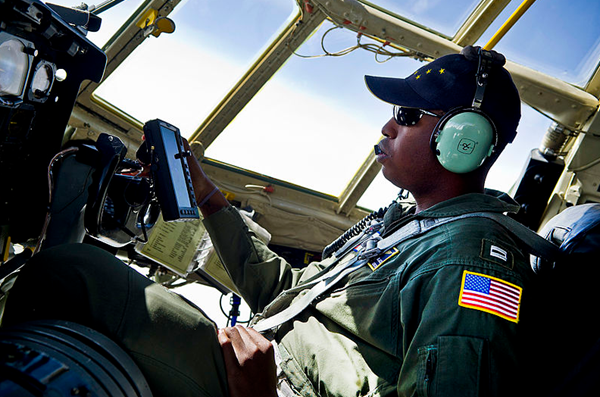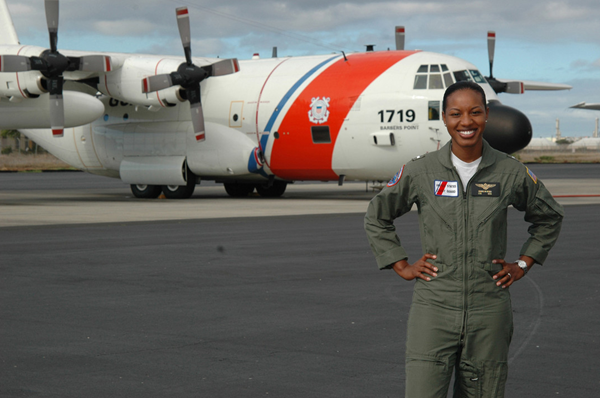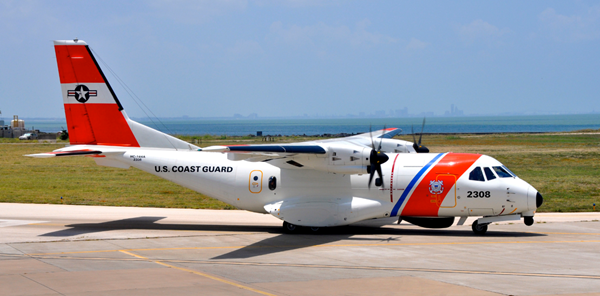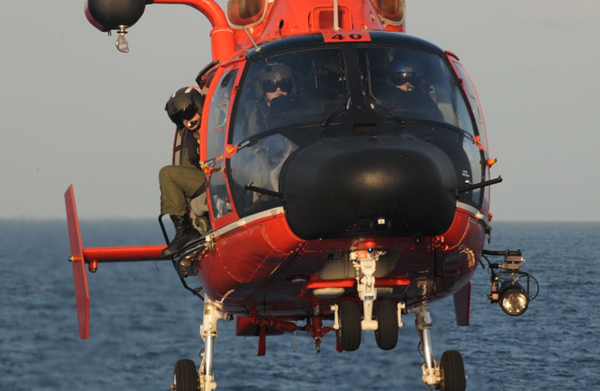Coast Guard pilots are the ones that you see performing search and rescue missions in adverse weather situations.
They are the ones that provide response when there is an environmental issue, protecting the waterways, people, and aquatic life.
According to their website, they have approximately 800 pilots in their workforce.
Being one of the few selected to pilot the Coast Guard’s aircraft is an honor.
This article will cover the Coast Guard pilot requirements and the three paths you can take to join.
Related Article: List of Coast Guard Bases In The US
Basic Requirements for Coast Guard Pilot Requirements

Age: The minimum age to enter the Coast Guard is 17, however, officers must be at least 21 and the age limit without a waiver is 27.
Applicants can use a waiver up to age 31 if they are over the age of 27.
The age limit for the DCA (Direct Commission Aviation) path, which is those who have prior military aviation experience, is 36 years old.
Height: Pilots are required to be between 62″ and 77″ due to ejection seat limitations.
Weight: Weight limits are the same for enlisted entry and are based on factors such as gender, height and body fat. Find the chart here.
Education: A high school diploma is required to join the Coast Guard.
Vision: Future pilots must have full color vision, depth perception, and vision correctable to 20/20.
Clearance: Regardless of the path, Coast Guard Officers must pass a Secret Clearance.
Citizenship: All applicants must be U.S. Citizens.
Dependency: If single, you will need a waiver if you have any dependents under the age of 18.
You also cannot have more than three dependents upon entering service, including your spouse.
Advanced Requirements for Coast Guard Pilot Requirements
ASVAB: A score of 109 on the General Technical (GT) section is required through most pathways.
An SAT score of 1100 (critical reading and math) or ACT score of 23 (composite) is also acceptable.
Medical: Initial entry into the Coast Guard will require passing a basic military entrance medical exam at a military entrance processing station (MEPS).
All individuals must pass a Class 1A flight physical examination.
This examination is an in-depth examination that covers extensive medical history and requires multiple blood and physical testing procedures.
The test is to ensure that there are no prior or current medical issues that could have an impact on safety during flight.
Some prior medical conditions such as head or spinal injuries can be disqualifying, as well as asthma after the age of 12.
There are some medical issues that can be waived, but this is on a case-by-case basis.
Education: Those who take the Commissioned Officer path must have a four-year college degree.
The WiFI path requires you to be accepted and enrolled in a bachelor’s degree program with no more than two years left till completion.
The Direct Commissioned Officer path requires a four-year college degree or a combination of college credit and experience, depending on your officer status prior to entering.
Related Article: Army Helicopter Pilot Requirements
What happens if you are selected for training?
There are three paths that you can take to receive training as a pilot in the Coast Guard.
Path 1: Commissioned Officer
Commissioned officers can enter into the aviation program after completion of officer training.
To become a Commissioned Officer in the Coast Guard you must either attend the Coast Guard Academy or attend Officer Candidate School after receiving a minimum of a bachelor’s degree.
Coast Guard Academy
The Coast Guard Academy is open to high school graduates who would like to attend college while earning a commission.
It is located in New London, Connecticut. and has a little less than 1,100 students in its undergraduate program.
This program results in a bachelor’s degree and a commission.
Getting into flight school through this path is not guaranteed.
Individuals will compete to get into the aviation program.
Officer Candidate School
Coast Guard Officer Candidate School is 17 weeks long and focuses on providing Coast Guard members with the skills to be adequate leaders.
It is open to civilians or current enlisted members.
Toward the end of Officer Candidate School, individuals will compete for assignments in available areas.
Their progression and success in the program will have an effect on their ability to join the aviation program.
Path 2: Wilkes Flight Initiative (WiFI)
The Wilkes Flight Initiative is open to those in the College Student Pre-Commissioning Initiative, (CSPI) program.
CSPI is a scholarship program that ends with individuals receiving a guaranteed commission as an officer.
During their senior year of college, individuals can apply for this program.
This program is unique because it allows for applicants to have a guaranteed flight school position, versus those that take the direct OCS path, who have to compete for a position.
This pathway requires a four-year initial active duty service enlistment. When you graduate from OCS, your enlisted contract will expire and you’ll have an active duty officer obligation of 3 years.
If you’re selected for flight school and complete that, you’ll have an additional service requirement of 8 years, for 11 years in total.
After completing school, WiFI applicants will attend Officer Candidate School prior to flight school.
Additional requirements for this program include:
- WiFI application interview and three letters of recommendation
- Take the ASTB (Aviation Selection Test Battery) and receive a score of 4 on AQR (Academic Qualification Rating) and 5 on PFAR (Pilot Flight Aptitude Rating).
Flight School

Those who attend Officer Candidate School, either by entry or after the WiFI program, will attend Flight School at the Navy Air Station in Pensacola, FL.
The Flight School training pipeline for Coast Guard pilots is similar to Navy and Marine Corps training.
Air Pre-Flight Indoctrination Course
The first part of Flight School is to attend the Air Pre-Flight Indoctrination Course.
The Air Indoctrination Course is six weeks in length and aims to teach future pilots about basic aircraft systems and regulations.
The course curriculum includes learning aerodynamics, navigation, aircraft engines and systems, weather, and flight rules and regulations.
Through physical training, field training, and classroom instruction, students will learn how flying affects the body as well as water and land survival.
Related Article: How To Join The Coast Guard
Primary Training
Upon successful completion of the Air Pre-Flight Indoctrination Course, future pilots will go to Primary Training.
Primary Training can be at either Naval Air Station Whiting Field, Pensacola, Florida, or Naval Air Station Corpus Christi in Corpus Christi, Texas.
Students will train on the T-6B Texan II in both locations.
They will learn basic instrument flying, visual flight, ground-based academics, and simulated training and will be required to complete several solo flights.
This course can be up to 22 weeks long.
Intermediate and Advanced Training
Advanced training will either be conducted at Whiting Field, Florida, or Corpus Christi, Texas.
The path that you take will depend on the aircraft you are assigned.
Those who will receive rotary-wing training will go to Whiting Field, while those who will receive fixed-wing training, will go to Corpus Christi.
Although your preference is considered, Coast Guard demand is what ultimately decides which aircraft you will pilot.
Advanced training will focus on expanding navigation skills and aviation functions.
Pilots will learn to master their aircraft in adverse weather scenarios and emergency situations through flight time and simulated flight time.
They will learn mission responsibilities respective to their particular aircraft.
Advanced training length can vary based on the path and the success of the aviator and aircraft but generally lasts around 20 weeks.
Path 3: Direct Commission Aviator
Applying through the Direct Commission Aviator (DCA) program allows individuals to expect a career as an aviator.
This program is open to pilots from other services.
Officers will execute a permanent change of station and report to their new duty station for a short period of time prior to attending the Direct Commission Aviator course.
The Direct Commission Aviator course is in New London, Connecticut, and is approximately five weeks in length.
The course covers Coast Guard traditions, administration essentials, and programs related to the Coast Guard.
After completing the Direct Commission Aviator course, they will return to their unit.
Direct Commission Aviator officers will transition into flying Coast Guard aircraft and attend the Aviation Training Center in Mobile, Alabama.
This program will result in a five-year active duty service obligation.
This program has additional requirements to the ones listed above:
- Two years minimum active duty service as an Army Warrant Officer or a commissioned officer in any US Armed Forces, but no more than 10 years of active duty service, with pilot being the primary employment
- 500 hours of manned, non-flight training/simulator, flight time
- Approved DD 368 conditional release form
- Completion of a U.S. military flight training program
Aviation Training
The Direct Commission Aviator path requires pilots to have already completed flight school.
In order for Direct Commission Aviator officers to become familiar with Coast Guard aircraft, they will attend aviation training at The Coast Guard Aviation Training Center in Mobile, Alabama.
Training will be conducted on one of the Coast Guard’s aircraft:
- MH-60 Jayhawk
- MH-65 Dolphin
- HC-130 Hercules
- HC-130J Hercules
- HC 144 Ocean Sentry
While the exact training details may vary depending on the aircraft, students will learn Coast Guard mission responsibilities.
Students can learn Search and Rescue, Homeland Security, and Environmental Protection mission functions.
Related Article: Marine Corps Pilot Requirements
What happens after training?
After completing training, Coast Guard members must be ready for assignment to any location around the world.
An assignment officer will assign a location based on the needs of the Coast Guard.
Those who attended the Aviation Training Center are required to return once a year for a one-week proficiency course.
Coast Guard aviators can expect assignments in the aviation career track as well as working within aviation training.
There are options for special assignments after training as well.
Special assignments are within sub-specialties such as training or human resources.
Conclusion

Coast Guard pilot requirements vary based on the path that you take to become one.
All paths require applicants to be of good moral character, pass background checks, and become leaders as officers in the Coast Guard.
Coast Guard pilots provide assistance and mission support whenever it is needed.
Through the three pathways, you can become a Coast Guard pilot and earn your wings.
Related Article: Navy A School: A List Of All 24 Locations + Training Summary
References
- Pure Rawz Review: Legit Peptides & SARMS Or Fraud? - November 26, 2023
- American Flag With Circle Of Stars (Betsy Ross) Explained - November 23, 2023
- 20 Best Military War Movies Of All-Time - November 22, 2023
General FAQ
Does the Coast Guard train pilots?
The Coast Guard gets the majority of its pilots from other branches of the U.S. military. However, it also has its own training program in coordination with flight school training for Navy pilots.
How long does it take to become a Coast Guard pilot?
If you have no prior service experience as a pilot, becoming a pilot in the Coast Guard can take about a year after graduating Officer Candidate School.
How many Coast Guard pilots are there?
The Coast Guard currently has about 800 pilots, with around 2,500 enlisted personnel in support of the USCG’s aerial mission.
How much money does a Coast Guard pilot make?
Like all military branches, the Coast Guard pays its pilots according to rank and time in service. However, this base pay also includes allowances and bonuses such as Aviator Career Incentive Pay and flight pay.
Does the Coast Guard go to war?
The Coast Guard is officially part of the Department of Homeland Security, rather than the Department of Defense. But, it's considered part of the U.S. military because in times of war, the president can transfer its assets to the Navy.

